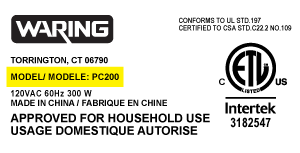GSR23YBWHSS General Electric Refrigerator - Instructions
Keep searches simple. Use keywords, e.g. "leaking", "pump", "broken" or "fit".
No power to the fan and compressor
I have a fridge in my garage. I have found that a glass of ice water or a cold drink outside is very important to me. When I discovered melting ice dripping onto the garage floor I was very upset. I spun the fridge and found that the compressor and fan weren't starting. I got out my multi-meter and discovered that power was not making it to these components. I did some research and found the wiring diagram online. There really isn't too much going on with a fridge and the most likely candidate seemed to be the run capacitor. I ordered the part, replaced it in a few minutes and the fridge began working again.
Parts Used:
-
Christian from Kearneysville, WV
-
Difficulty Level:Really Easy
-
Total Repair Time:Less than 15 mins
-
Tools:Screw drivers
222 of 301 people
found this instruction helpful.
Was this instruction helpful to you?
Thank you for voting!
Refrigerator too cold
My repair experience was a little more complicated than previous posts, but nothing major. And most importantly replacing the Fresh Food Air Inlet Cover did fix my problem. Here are the steps I followed:
1. You will need to remove a minimum of the top two shelves to get access to the Air Inlet Cover. It runs along the back of the fridge and connects to a hole to the freezer side. It has a little fan inside that sucks the cold air from the freezer and diverts to the top and bottom of the fridge.
2. As mentioned in other posts, there are four screws holding the Inlet Cover in place, 2 lower and 2 upper. To get access to the lower two screws,you simply pop off the lower duct assembly (squeeze the sides). Be careful when removing and installing these screws. If you drop one into the lower duct, you will add a few more steps to the installation to remove more shelves and take out the lower duct to get to where the screw fell. Obviously this happened to me. Not difficult to do, just adds more time.
3. To access the upper two screws I had to remove the top light cover (one screw) and then slide out the top duct/diffuser assy (my name, not GE's).
4. Finally to get clearance to pull out the Inlet Cover, I had to remove the water filter and cover. When you pull away the Inlet Cover, you will see the electrical connection that is simple to disconnect.
5. After I removed my Inlet Cover, it was obvious that it was broken because it rattled and I could peek inside to see that the plastic air diverter/flapper thingy was broken.
6. One final surprise was that the replacement Air Inlet Cover did not exactly match the one I removed. The replacement only had one upper air outlet, while my old one had three upper outlets, left, right and center. I noticed there was a plastic cover over one of the side outlets on the replacement, so I just popped that off and hoped for the best.
7. The replacement Air Inlet Cover Kit came with sticky back insulation that you attach to where the Inlet Cover meet the freezer access hole to make sure snug fit to limit extra cold air leaking into the fridge side.
8. Installation of the replacement Air Inlet Cover was fairly easy, just follow the above steps in reverse and make sure you don't drop any screws.
It's been a couple of weeks since I performed this installation and my fridge has been maintaining temperature perfectly. No more frozen milk or lettuce. The wife is very happy.
1. You will need to remove a minimum of the top two shelves to get access to the Air Inlet Cover. It runs along the back of the fridge and connects to a hole to the freezer side. It has a little fan inside that sucks the cold air from the freezer and diverts to the top and bottom of the fridge.
2. As mentioned in other posts, there are four screws holding the Inlet Cover in place, 2 lower and 2 upper. To get access to the lower two screws,you simply pop off the lower duct assembly (squeeze the sides). Be careful when removing and installing these screws. If you drop one into the lower duct, you will add a few more steps to the installation to remove more shelves and take out the lower duct to get to where the screw fell. Obviously this happened to me. Not difficult to do, just adds more time.
3. To access the upper two screws I had to remove the top light cover (one screw) and then slide out the top duct/diffuser assy (my name, not GE's).
4. Finally to get clearance to pull out the Inlet Cover, I had to remove the water filter and cover. When you pull away the Inlet Cover, you will see the electrical connection that is simple to disconnect.
5. After I removed my Inlet Cover, it was obvious that it was broken because it rattled and I could peek inside to see that the plastic air diverter/flapper thingy was broken.
6. One final surprise was that the replacement Air Inlet Cover did not exactly match the one I removed. The replacement only had one upper air outlet, while my old one had three upper outlets, left, right and center. I noticed there was a plastic cover over one of the side outlets on the replacement, so I just popped that off and hoped for the best.
7. The replacement Air Inlet Cover Kit came with sticky back insulation that you attach to where the Inlet Cover meet the freezer access hole to make sure snug fit to limit extra cold air leaking into the fridge side.
8. Installation of the replacement Air Inlet Cover was fairly easy, just follow the above steps in reverse and make sure you don't drop any screws.
It's been a couple of weeks since I performed this installation and my fridge has been maintaining temperature perfectly. No more frozen milk or lettuce. The wife is very happy.
Parts Used:
-
Marc from Orlando, FL
-
Difficulty Level:A Bit Difficult
-
Total Repair Time:1- 2 hours
-
Tools:Screw drivers
156 of 163 people
found this instruction helpful.
Was this instruction helpful to you?
Thank you for voting!
Warm freezer and no ice
This story starts with a GE side-by-side refrigerator that has always had wide temperature swings and a temperamental water dispenser. The ice maker was not making ice, and the built in digital thermometer showed it was running warm. I suspected that the heat exchanger was full of dust and so looked there. What I found was that the condenser tank was hot to the touch and the fan wasn’t running. As an experiment, I aimed a fan at the it for a while I saw that the freezer temperature dropped back to normal.
.The fan is marked as 11.2 DC so I checked for voltage at the fan and found some. With three wires and no wiring diagram I wasn’t sure this answered all the questions, but hooking the fan to a 12 volt power supply didn’t get it to spin.
I priced parts at a couple websites before using partselect.com . They also have a good diagram to look at (Sears diagrams are really poor). I ordered the part with 2-day shipping; it arrived on time, was correct and fixed the problem.
.The fan is marked as 11.2 DC so I checked for voltage at the fan and found some. With three wires and no wiring diagram I wasn’t sure this answered all the questions, but hooking the fan to a 12 volt power supply didn’t get it to spin.
I priced parts at a couple websites before using partselect.com . They also have a good diagram to look at (Sears diagrams are really poor). I ordered the part with 2-day shipping; it arrived on time, was correct and fixed the problem.
Parts Used:
-
Paul from Suwanee, GA
-
Difficulty Level:Easy
-
Total Repair Time:30 - 60 mins
-
Tools:Nutdriver
95 of 131 people
found this instruction helpful.
Was this instruction helpful to you?
Thank you for voting!
fan not running
Removed rear and front grills,brushed and vacuumed area- probably caused the fan motor to fail- unplugged fan, removed fan,motor,and shroud in 1 piece, carefully slipped fan off motor shaft, unscrewed shroud and motor. assembled in reverse order. Frige is in tight area, .I'll now roll it out and clean often
Parts Used:
-
Ray from Bensalem, PA
-
Difficulty Level:A Bit Difficult
-
Total Repair Time:15 - 30 mins
-
Tools:Nutdriver, Socket set
74 of 104 people
found this instruction helpful.
Was this instruction helpful to you?
Thank you for voting!
dropped something on the light switch and it broke off
we just pried out the old switch and pulled it out the rest of the way with a pair of needle nose pliers. Pulled off the wires on the broken switch and reattached to the new one and just slid/clicked it back into the hole.
Parts Used:
-
Lorinda from Dallas, TX
-
Difficulty Level:Really Easy
-
Total Repair Time:Less than 15 mins
-
Tools:Pliers, Screw drivers
59 of 66 people
found this instruction helpful.
Was this instruction helpful to you?
Thank you for voting!
Not cold & saw ice accumulated on freezer back panel
-Disconnect the power supply wire& turn temp control inside refrigerator to 0!
-15 mins spent on remove (5 screws) the back panel inside freezer, melt ice then replace the heater (2 screws) on the bottom! Black wire on left & pink wire on the right! Make sure both end has good connection to the heater!
-30 mins to drain all water from the bottom (back side) of the refrigerator, suck & clean all dust & dirt from the front & back side!
-Set both temp control knots to 5 & put back all the food!
-If no ice build up on the panel after 10 days & then the repair is good!
-15 mins spent on remove (5 screws) the back panel inside freezer, melt ice then replace the heater (2 screws) on the bottom! Black wire on left & pink wire on the right! Make sure both end has good connection to the heater!
-30 mins to drain all water from the bottom (back side) of the refrigerator, suck & clean all dust & dirt from the front & back side!
-Set both temp control knots to 5 & put back all the food!
-If no ice build up on the panel after 10 days & then the repair is good!
Parts Used:
-
Eddie from Freeport, NY
-
Difficulty Level:Really Easy
-
Total Repair Time:Less than 15 mins
-
Tools:Screw drivers
52 of 64 people
found this instruction helpful.
Was this instruction helpful to you?
Thank you for voting!
Fridge smelled like something electronic was burning
Removed the back cover of the fridge with it still pluged in. The next time the compressor tried to kick on, a small piece of black plastic next to the black tank caught fire, and then went out. I unpluged the fridge, unpluged the two wires feeding the black box. Then the box unpluged from the tank. I searched on the internet for the part using the model #. It ended up being a overload/ptc or relay. There was a smaller black box attached with I think is some sort of an overload. I unplugged the overload and it plugged right into the new relay I had overnighted. Although the new relay was white (not black) and the plug attachments were in different locations, it work great.
Parts Used:
-
BENJAMIN from LAKESIDE, CA
-
Difficulty Level:Easy
-
Total Repair Time:15 - 30 mins
-
Tools:Nutdriver
50 of 59 people
found this instruction helpful.
Was this instruction helpful to you?
Thank you for voting!
bad light socket
unplugged refrigerator. removed light bulb from old socket. unsnapped old light socket and pulled it out just enough to diconnect the electrical plug that plugs into the socket . discarded the old socket and plugged in new socket. snapped in new socket into refrigerator. i watched how to do this simple procedure on you tube and decided to do it myself. easy easy easy
Parts Used:
-
nancy from silsbee, TX
-
Difficulty Level:Really Easy
-
Total Repair Time:Less than 15 mins
45 of 56 people
found this instruction helpful.
Was this instruction helpful to you?
Thank you for voting!
Relay
Removed back panel. Opened cover to relay attached to the compressor and pulled off replacing with new relay. No problem.
Better than paying $250 for someone else to do it.
Better than paying $250 for someone else to do it.
Parts Used:
-
John H from Austin, TX
-
Difficulty Level:Really Easy
-
Total Repair Time:15 - 30 mins
41 of 53 people
found this instruction helpful.
Was this instruction helpful to you?
Thank you for voting!
Refrigerator Not Cooling due to ice buildup on coils
Removed shelves from freezer section and removed protective cover using a screwdriver and nutdriver. 5 screws.
Upon removal of the cover, I noticed the coils totally cover with ice. At this point I noticed that the defrost heater was burnt out. I removed the heater using screwdriver and pliers and tested the heater according to instructions from Parts Select website.
Since the coil was exposed, I also tested the defrost thermostat according to Parts select instructions and found it to be working properly. i also tested the defrost timer and found it OK.
I replaced the heater, closed the protective cover, replaced the shelves and plugged the unit on.
It has been working just fine since then..
In addition to saving money, i saved myself the agravation of looking for a repairman and having to wait for THEIR convenience to to the work.
Upon removal of the cover, I noticed the coils totally cover with ice. At this point I noticed that the defrost heater was burnt out. I removed the heater using screwdriver and pliers and tested the heater according to instructions from Parts Select website.
Since the coil was exposed, I also tested the defrost thermostat according to Parts select instructions and found it to be working properly. i also tested the defrost timer and found it OK.
I replaced the heater, closed the protective cover, replaced the shelves and plugged the unit on.
It has been working just fine since then..
In addition to saving money, i saved myself the agravation of looking for a repairman and having to wait for THEIR convenience to to the work.
Parts Used:
-
FERNANDO from MIAMI, FL
-
Difficulty Level:Really Easy
-
Total Repair Time:30 - 60 mins
-
Tools:Pliers, Screw drivers
35 of 41 people
found this instruction helpful.
Was this instruction helpful to you?
Thank you for voting!
Water line froze, food in fridge started freezing
I knew almost as soon as I found the frozen milk that the air-flow diverter, whatever it's called, had broken. It's a plastic part that opens and closes to allow cold air from the freezer into the fridge side.
Step one: clear off the top two shelves and take them out.
Step two: remove the lower piece of the assembly. It pops straight out at the top and drops down after that. If you pull the bottom straight out, you may break the bits that holds it to the fridge wall.
Step three: remove screws holding in light, and then the screws holding in the AASM COVER FF INLET K (wish I had a better name for it).
Step Four: Unplug the unit from the fridge wall.
Installation, reverse, except maybe unplug the unit earlier.
Step one: clear off the top two shelves and take them out.
Step two: remove the lower piece of the assembly. It pops straight out at the top and drops down after that. If you pull the bottom straight out, you may break the bits that holds it to the fridge wall.
Step three: remove screws holding in light, and then the screws holding in the AASM COVER FF INLET K (wish I had a better name for it).
Step Four: Unplug the unit from the fridge wall.
Installation, reverse, except maybe unplug the unit earlier.
Parts Used:
-
Bradley from Spokane, WA
-
Difficulty Level:Easy
-
Total Repair Time:30 - 60 mins
-
Tools:Screw drivers
33 of 37 people
found this instruction helpful.
Was this instruction helpful to you?
Thank you for voting!
The clear plastic module shelf insert broke because I dropped it.
I popped out the old one and popped in the new one.
Parts Used:
-
Morgan from Acworth, GA
-
Difficulty Level:Really Easy
-
Total Repair Time:Less than 15 mins
30 of 36 people
found this instruction helpful.
Was this instruction helpful to you?
Thank you for voting!
freezer coils not thawing and fridge getting warm.
Replacing the heater is very easy. Remove the wire racks and the two lower rack bracket screws. Remove the two screws to the back panel, unclip the ground wire and remove the panel. Two screws hold he heater on and two wires for the connection.
However, this did not solve my problem. The story is this. The fridge was getting warm because the coils were freezing over. I called the local repair guys "poncho and lefty" and they came out and replace the themostat and charged me $150. It still froze over a week later. They came back and said it must be the circuit board and charged me just for the $125 part. Nope, it still froze over in a week. So I thought I would take things into my own hands and tell poncho and left to hit the trail. I then ordered a new heater because the old one looked bad even though it checked out okay with an ohm meter. Unfortunately, that didn't solve the problem either. The last thing is to replace are the temp sensors. But before I ordered anything I submitted my problem to a "fix it" forum and someone suggested to check the part number of the themostat that was put in. This turned out to be a brilliant observation. It seems poncho and lefty replace the thermostate with one that is used with a timer. This fridge has the timer built into the circuit board and has a very different temp range than the one they replace it with. Their first clue should have been that the wires were a different color than the one they were replacing and that the part number was totally different than the one they took out. So I ordered a new thermostat and the three temp sensors and replace all of this and the unit works as good as new. The forum also told me that the bullet shaped temp sensor were faulty and should all be replaced, which I did.
Now I have all new parts, so it should be good to go until the compressor takes a nose dive. Hopefully, that will not be for 5 or 6 more years.
However, this did not solve my problem. The story is this. The fridge was getting warm because the coils were freezing over. I called the local repair guys "poncho and lefty" and they came out and replace the themostat and charged me $150. It still froze over a week later. They came back and said it must be the circuit board and charged me just for the $125 part. Nope, it still froze over in a week. So I thought I would take things into my own hands and tell poncho and left to hit the trail. I then ordered a new heater because the old one looked bad even though it checked out okay with an ohm meter. Unfortunately, that didn't solve the problem either. The last thing is to replace are the temp sensors. But before I ordered anything I submitted my problem to a "fix it" forum and someone suggested to check the part number of the themostat that was put in. This turned out to be a brilliant observation. It seems poncho and lefty replace the thermostate with one that is used with a timer. This fridge has the timer built into the circuit board and has a very different temp range than the one they replace it with. Their first clue should have been that the wires were a different color than the one they were replacing and that the part number was totally different than the one they took out. So I ordered a new thermostat and the three temp sensors and replace all of this and the unit works as good as new. The forum also told me that the bullet shaped temp sensor were faulty and should all be replaced, which I did.
Now I have all new parts, so it should be good to go until the compressor takes a nose dive. Hopefully, that will not be for 5 or 6 more years.
Parts Used:
-
Gerald from Ada, MI
-
Difficulty Level:Easy
-
Total Repair Time:15 - 30 mins
-
Tools:Screw drivers
26 of 32 people
found this instruction helpful.
Was this instruction helpful to you?
Thank you for voting!
Fridge Door would not close "automagically"
I had to remove the fridge door (side by side), which took approximately 10min (most of which was retrieving the right size socket wrench from the garage). With the door removed, I could replace the broken door closing cam and door stop... with 4 screws. Not much to it. Had the door mounted back on in another 5min and that was it. :)
Parts Used:
-
David from Cary, NC
-
Difficulty Level:Really Easy
-
Total Repair Time:15 - 30 mins
-
Tools:Screw drivers, Socket set
24 of 33 people
found this instruction helpful.
Was this instruction helpful to you?
Thank you for voting!
Light would not work when I opened door.
I lifted the old switch with a flat screwdriver, attached wires, and popped into place. Saved 80 bucks for a repair call.
Parts Used:
-
joe from spartanburg, SC
-
Difficulty Level:Really Easy
-
Total Repair Time:Less than 15 mins
-
Tools:Nutdriver
22 of 28 people
found this instruction helpful.
Was this instruction helpful to you?
Thank you for voting!



































